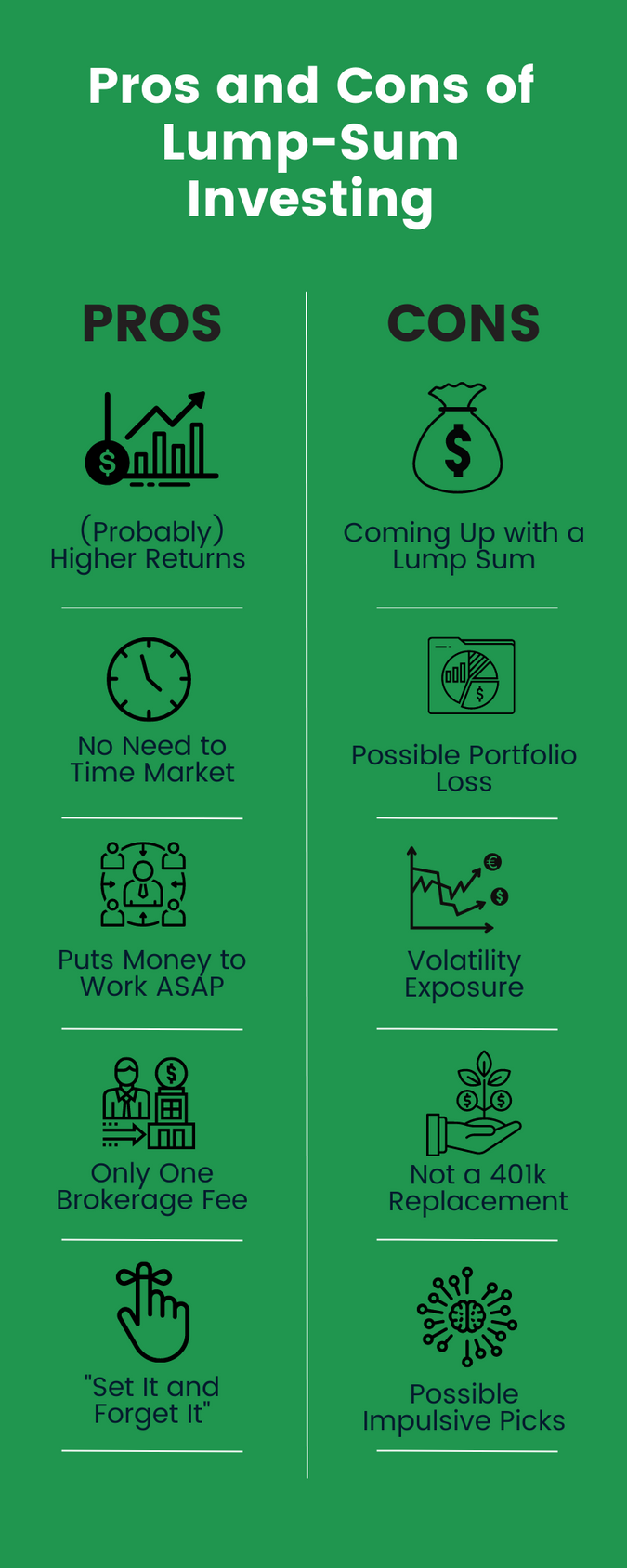Pros and Cons of Lump-Sum Investing

There’s an age-old debate among investors about whether it’s better to invest one lump sum as soon as possible, or spread out your investments over time. The reason the debate still continues is that there simply isn’t one right or wrong answer.
Explore: Your Biggest Money Etiquette Questions Answered
Looking To Diversify in a Bear Market? Consider These 6 Alternative Investments
Both lump-sum investing, where you put all your money in at one time, and dollar-cost averaging, in which you make regular investments over time, have their strengths and weaknesses. When thinking about which path to take, consider your personality as an investor. For some, putting all your money into an investment at once amounts to “putting all your eggs in one basket,” which can feel risky. Others approach the debate with the belief that getting money into the market as early as possible gives you more time to earn a return.
To help you figure out which may be the best choice for you, here’s a look at the pros and cons of lump-sum investing.

Pro: Potentially Higher Returns
Wall Street is full of axioms, and one of the most-quoted says that “it’s time in the market, not timing.” What this means is that over time, the power of compound interest can really juice your returns. The longer you are invested, the more time you’re giving compound interest to work its magic.
For example, if you invest $10,000 at a 10% return for 50 years, you’ll end up with about $1.45 million. But if you wait just 10 years and only invest that money for 40 years, you’ll only have about $537,000. Starting to invest just 10 years earlier nearly triples your ultimate return, and that’s something most people would consider quite significant. Investing your money as fast as you can in a lump sum can give you more time in the market than investing a little bit at a time, so it may offer you the chance for higher total returns.
Con: Coming Up With a Lump Sum
One of the problems of lump sum investing is that not all investors have a pile of cash simply lying around. In fact, if you’re just starting from scratch, waiting to build up cash reserves to invest might actually counteract one of the supposed benefits of lump sum investing, which is to invest as soon as possible.
If it takes you months or years to accumulate a lump sum to invest, you’ll actually be missing time in the market rather than taking advantage of it. Instead of waiting to grow your lump sum, you could deploy that money a little bit at a time rather than letting it build up in a savings account.
Take Our Poll: Do You Think You Will Be Able To Retire at Age 65?
Pro: No Need To Time the Market
Remember that Wall Street axiom about “time in the market, not timing?” The second half of that phrase is another troublesome idea for most investors. Timing the market is difficult, stressful and often emotional. Market timers tend to put their money in when the market is booming and they are feeling euphoric, which often marks the top of the market. They also tend to pull money out when the market has dropped significantly and sentiment is negative, thereby missing out when the market bounces back.
If you invest a lump sum, however, you don’t have to worry about timing the market because you’re only investing once. This can remove anxiety, stress and time-consuming market research from your daily life.
Con: Possible Portfolio Loss
When you put all your money into the market at one time, you run the risk of investing right before a correction or a bear market. Although over time the markets have always recovered from selloffs, it can be tough emotionally to sit and watch as your entire portfolio immediately drops by 10% or 20%.
If you’re not disciplined as an investor, you might feel a compelling urge at this point to take your money out, which could be catastrophic to your long-term returns as you lock in your loss and then watch the market go higher.
Pro: Puts Money To Work ASAP
Money that’s not working can actually cost you financially. Even if your money is in a savings account earning 2% interest, after taxes and inflation you are no doubt technically losing money in terms of real returns.
That’s why it’s so critical to get your money invested in higher-yielding investments, like the stock market, as soon as possible. Investing with a lump sum is the fastest possible way to get your money earning a higher return, and over the long run, this can pay big dividends. In that sense, waiting to invest monthly, quarterly or annually rather than immediately can actually be costing you money.
Con: Volatility Exposure
If you only have a little bit invested in the market, volatility may not bother you. In fact, it can prove to be an opportunity, as when the market is down, you will still be adding more money to your account and buying shares more cheaply.
But if your entire portfolio is in the market all at once, even a modest selloff can be frightening. For example, if you put $200,000 into your account all at once and the market drops by 10%, you’ll suddenly be looking at a loss of $20,000. That’s a significant amount, especially if you just invested all that money.
Pro: Only One Brokerage Fee
By investing a lump sum, you don’t have to worry about repeated brokerage fees. If you use a commission broker, every time you invest you may have to pay a fee, whereas with a lump sum, you’ll only pay that fee once. If you use a no-commission broker, you may face other fees or limitations, such as a small lot trading fee, a minimum balance requirement or an account maintenance fee that is a higher percentage of your total portfolio. Whichever fees you may encounter, it’s best to be able to pay them one time rather than repeatedly.
Con: Not a 401(k) Replacement
Investing as much as you can on your own is a great idea. However, for most Americans, a retirement plan like a 401(k) is still the best option for building a nest egg. For starters, you’ll get a tax deduction on your 401(k) contributions, and your money will grow tax-deferred. That alone can put you ahead of the game when it comes to investing.
However, most employers will also match a certain percentage of your 401(k) plan contributions, and this is the closest thing to “free money” you’re likely ever to get. Over time, those annual matching contributions can build up to become a significant percentage of your final nest egg. If you try to use a lump sum investment as a 401(k) replacement, you will likely fall behind what you could have achieved if for no other reason than you won’t have those additional contributions being made to your account every year.
Pro: ‘Set It and Forget It’
One of the biggest advantages of investing with a lump sum is that you can simply buy your investments once and be done with the process. For many people, trying to analyze investments and deal with day-to-day market fluctuations can be burdensome and stressful. But if you put all your money in once and just let it be, all those worries disappear.
Assuming you’ve selected a portfolio that’s in line with your investment objectives and risk tolerance, if you invest with a lump sum you can essentially “set and forget” your portfolio, subject to the occasional review.
Con: Possible Impulsive Picks
A downside of dumping all of your money into a portfolio all at once is that you’re likely to invest in stocks that you’re interested in at that one moment in time. In other words, you may be susceptible to impulsive picks. In addition to long-term investments like Berkshire Hathaway or Johnson & Johnson, for example, you might be enamored with meme stocks like AMC Entertainment or GameStop.
While some traders can and do make money turning over these volatile names, they may not be ones that you want to hold for, say 40 years, and you certainly don’t want to put your entire portfolio into them. So, if you only invest one time and “set and forget” your portfolio, you may not be nimble enough to prune speculative names if they’re crashing.
More From GOBankingRates
This article originally appeared on GOBankingRates.com: Pros and Cons of Lump-Sum Investing

 Yahoo Finance
Yahoo Finance 